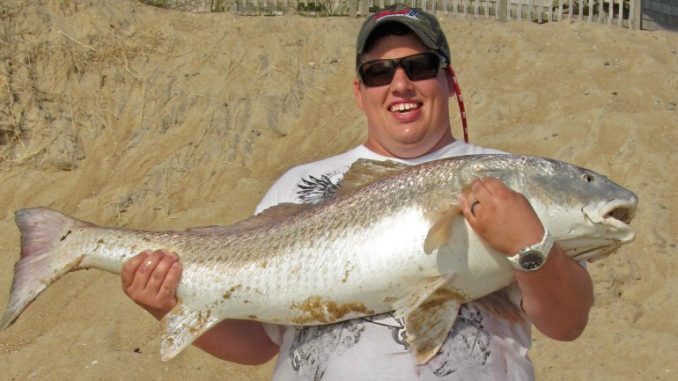
Redfish run on for surf fishing fanatics
Two times each year — spring and fall — surf anglers can cast baited bottom rigs with Hatteras Heavers at “old” (big) red drum at North Carolina’s central and northern beaches.
Anglers are catching large reds right now at Cape Hatteras National Seashore with the only caveat they must carry their equipment for long distances to some stretches of beach, especially at the number-one red drum surf spot in the world — The Point near Buxton.These reds are returning from offshore and will head through Drum, Hatteras and Ocracoke inlets to Pamlico Sound where they’ll spawn then spend the summer. They’ll leave the sound for the ocean during late fall.
Terry Shive of Rowan County has spent many days fishing the Outer Banks beaches with family members for big red drum. Although he couldn’t go recently, he reported his son, Jason and wife Erin, along with Chevy Peake and wife Jennifer and their 4-month-old son Chevy Jr. (C.J.) were at Buxton this past week and discovered a good drum bite.
“It was Chevy’s first trip to Buxton and second day of fishing,” Shive said. “He used one of my old 11-foot rods and a Daiwa 4000 reel.
“Jason said Chevy caught the drum on his first cast Sunday morning (11 a.m.) but lost his wedding ring (he found it in the surf moments later but got soaked).”
Peake’s drum measured 46 inches, which earned a trophy-catch citation from the N.C. Division of Marine Fisheries.
Peake thought he’d caught a fish big enough to feed the entire crowd, Shive said, “but it broke his heart when he learned he had to release the fish (DMF rules allow one drum per day between 18 and 27 inches to be kept; all others must be released).”
“They had a southwest wind blowing, which brought to fish to shore, and Red Drum Tackle Shop reported 15 caught that day at (Cape Hatteras) Point (near Buxton),” Shive said.
The only problem was the arrival of piping plovers, a threatened bird species, closed access to The Point, so Jason Shive and his angling friends had to park and walk a mile to reach this fabled fishing spot.
“The Point is definitely closed (to ORV traffic),” Terry Shive said. “But as always, die-hards are parking as close as they can and walking to (The Point). The down side of not beach driving now, is that with a nor’easter’ you can drive in the back entrance to The Point, the coves to the west of it, and fish. The wind is at your back and you are usually blasted with sand, but you are also somewhat protected by dunes and tall banks, at least by the water’s edge.”
Driving permits cost $50 per week now at Cape Hatteras and $120 per year. Anglers who purchase ORV permits have to watch a 7-minute-long film showing ORV driving instructions and regulations.
Many favorite Cape Hatteras fishing spots will be closed to ORV and often pedestrian foot traffic until the birds and sea turtles leave the area in early October.
The Park Service’s new ORV rules have been put on hold by U.S. 4th District Court Judge Terrence Boyle, who has ordered his interim rules be kept in place until a lawsuit vs. the NPS ORV regs, filed by the Cape Hatteras Preservation Association, is settled. Nonetheless, the NPS is requiring ORV fees for beach driving (the NPS said it had the right under federal law to institute fees and has done so for the first time in the park’s 60-year history).


Be the first to comment